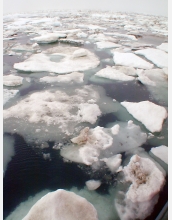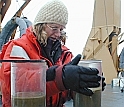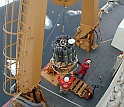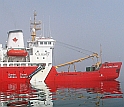|

Press Release 06-042
Bering Sea Ecosystem Responding to Changes in Arctic Climate

Effects could extend from base of food chain to native hunters
March 9, 2006
B-roll of Jackie Grebmeier and other NSF-funded researchers at work in Arctic waters is available. Contact Dena Headlee at dheadlee@nsf.gov. The B-Roll will also be available via satellite on Friday, March 10th COORDINATES: 3:30-3:45 PM ET IA 5/13 DL 3960V.
Physical changes--including rising air and seawater temperatures and decreasing seasonal ice cover--appear to be the cause of a series of biological changes in the northern Bering Sea ecosystem that could have long-range and irreversible effects on the animals that live there and on the people who depend on them for their livelihoods.
In a paper published March 10 in the journal Science, a team of U.S. and Canadian researchers use data from long-term observations of physical properties and biological communities to conclude that previously documented physical changes in the Arctic in recent years are profoundly affecting Arctic life.
The northern Bering Sea provides critical habitat for large populations of sea ducks, gray whales, bearded seals and walruses, all of which depend on small bottom-dwelling creatures for sustenance. These bottom-dwellers, in turn, are accustomed to colder water temperatures and long periods of extensive sea ice cover.
However, "a change from arctic to sub-arctic conditions is under way in the northern Bering Sea," according to the researchers, and is causing a shift toward conditions favoring both water-column and bottom-feeding fish and other animals that until now have stayed in more southerly, warmer sea waters.
As a result, the ranges of region's typical inhabitants can be expected to move northward and away from the small, isolated Native communities on the Bering Sea coast that subsist on the animals.
"We're seeing that a change in the physical conditions is driving a change in the ecosystems," said Jackie Grebmeier, a researcher at the University of Tennessee and one of the paper's co-authors.
Grebmeier said the new report is unusual in that it looks at the potential effects of a changing climate in the Arctic primarily through a life-sciences lens, rather than an analysis of the physics of climate change. "It's a biology driven, integrated look at what's going on," Grebmeier said.
Grebmeier is chief scientist for the Western Shelf-Basin Interactions (SBI) research project, which conducted a series of research cruises to observe changes in the carbon balance of the offshore areas of the Alaskan Arctic and their effects on the food chain. The cruises included a number of researchers supported by the National Science Foundation (NSF), the National Oceanic and Atmospheric Administration (NOAA), and other federal agencies.
NSF and the Office of Naval Research (ONR) jointly funded SBI.
NSF and NOAA also funded U.S. researchers who contributed data collected by the Bering Strait Environmental Observatory, which annually samples waters in the northern Bering Sea to assess the biological status of productive animal communities on the sea floor.
Those highly productive waters currently act as sponges for carbon dioxide, absorbing quantities of the gas that otherwise would remain in the atmosphere where it would be expected to contribute to warming. But, the researchers say, if the biological trends they observe in the northern Bering Sea persist and are not reversible, the accompanying shift in species and ecosystem structure could have important implications for the role of the sea as a "carbon sink."
James Overland, a co-author of the paper and an oceanographer at NOAA's Pacific Marine Environmental Laboratory (PMEL) in Seattle, added that the changes researchers are observing are not uniform throughout the Bering Sea. But both are tied to the nature of the sea ice.
"The northern Bering Sea ecosystem is changing as well as that in the southeast," he said. "In the southeast, fish population and (bottom-dweller) animal changes are happening in the context of a complete loss of sea ice. But in the northern Bering Sea, ecological changes are occurring in the context of shifts in the quality of the sea ice. The ice there is broken and thin compared with ice floes that were more the norm."
Satellite observations and other measurements, for example, combined with observations of native Yupik hunters, confirm that sea ice extent and thickness have become greatly reduced in recent years.
Also, observations by scientists on the SBI research cruises in 2004--scheduled for publication in a separate report in the journal Aquatic Mammals--confirm that walrus mothers were leaving their pups when sea ice the animals normally use as a summer resting platform retreated to the north.
Shifts in fish populations have also been observed, including the appearance much farther north of juvenile pink salmon in rivers that drain into the Arctic Ocean. Salmon feed on pollock, a species that is beginning to appear in larger numbers in the northern Bering Sea, possibly in response to warmer ocean temperatures.
"What we are seeing," Grebmeier concluded, "is a change in the boundary between the sub-Arctic and the Arctic ecosystem. The potential is real for an ecosystem shift that will be felt father north."
But, Overland noted, continued observations are needed to fully understand the scope and potential permanence of the changes. "Both physical and biological indicators need to be watched closely over the next few years to track the persistence of changes in the context of natural variability," he said.
-NSF-

Media Contacts
Peter West, NSF (703) 292-7761 pwest@nsf.gov
Jay Mayfield, University of Tennessee (865) 974-9409 jay.mayfield@tennessee.edu

The National Science Foundation (NSF) is an independent federal agency that supports fundamental research and education across all fields of science and engineering. In fiscal year (FY) 2009, its budget is $9.5 billion, which includes $3.0 billion provided through the American Recovery and Reinvestment Act. NSF funds reach all 50 states through grants to over 1,900 universities and institutions. Each year, NSF receives about 44,400 competitive requests for funding, and makes over 11,500 new funding awards. NSF also awards over $400 million in professional and service contracts yearly.
 Get News Updates by Email Get News Updates by Email
Useful NSF Web Sites:
NSF Home Page: http://www.nsf.gov
NSF News: http://www.nsf.gov/news/
For the News Media: http://www.nsf.gov/news/newsroom.jsp
Science and Engineering Statistics: http://www.nsf.gov/statistics/
Awards Searches: http://www.nsf.gov/awardsearch/
| 






